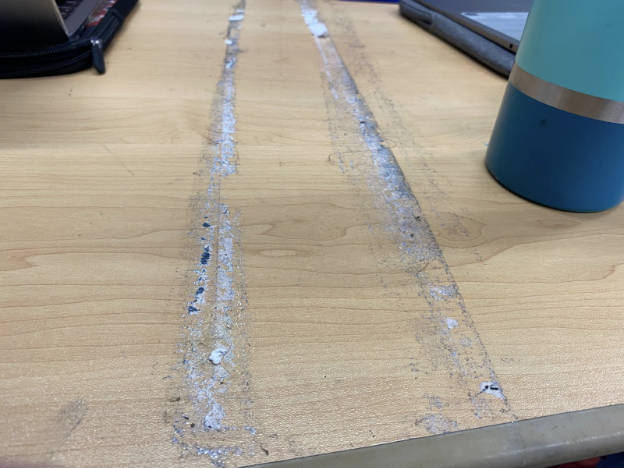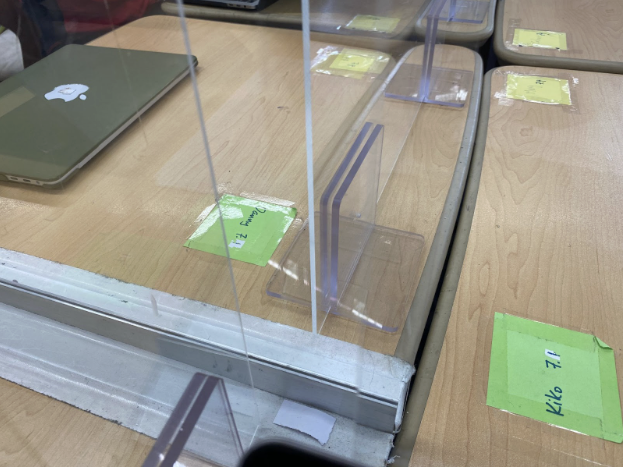Dividers topple across RCHK
By Colin Chan
In early November, RCHK students school-wide, recently invigorated by EOTC, found their classes void of the anti-epidemic dividers which had defined classroom design since the birth of the pandemic.
The change follows overhauls in classroom table layouts, the privilege of Amber Code faculty to work, the reinstatement of overnight camps, and optimistic plans to topple cafeteria dividers in January.
Uprooted dividers lie haphazardly in S101
“They [the dividers] have been removed everywhere except for the canteen,” stated Samuel Hureau, RCHK’s business manager and anti-epidemic policy coordinator.
Since the pandemic, Hureau has served as RCHK’s anti-epidemic liaison, interpreting requirements from the Centre for Health Protection (CHP), Education Bureau (EDB), and ESF. “I have to read all the memos… I have to implement what they [CHP, EDB, ESF] say. ”
“I was the one buying them [the dividers] and my team was installing them.”
A recently removed divider leaves a trail of duct tape residue in S304.
“The HK government had the feeling that they could handle another wave of Covid,” he hypothesized, believing the government’s repeal in policy stemmed from confidence in vaccination and hospital infrastructure.
Students rejoiced at the heightened opportunity to socialize. “I like it [the removal of dividers],” stated Year 11 student Saffron Law. “There’s more actual physical connection between students now because of it. They were just annoying. I literally scraped my arm so many times.”
“I feel like the removal of the dividers will help people interact socially,” commented Nathan Li, another Year 11 student. “Though I have heard that some people don’t like it because it won’t help them mark out their personal space anymore. Personally, I don’t really mind.”
He affirmed the removal of dividers would foster collaboration. “I feel like [the removal of dividers] will help a lot with group projects. If you were in a group project you might have three people on one side, but we couldn’t do that before because the dividers would cut the middle person.”
Tables in S101 are conjoined following the removal of dividers
Despite their removal in classrooms, dividers nonetheless stand in the cafeteria and undercover eating area, although Hureau is optimistic about the chances of their removal after Christmas.
“We plan to remove the dividers in the canteen and undercover area in January,” stated Hureau. “The CHP asked us to wait a little bit; they want to see what is going to happen [in classrooms],” he added, believing the CHP wants to assess the impact of a lack of dividers in classrooms before proceeding with eating areas. “Eating is the most dangerous time to spread Covid.”
“The removal of dividers from the lunch area to me is perfectly fine, but to the government it could be a concern as another outbreak might occur,” commented Li. “The dividers in the lunch area don’t really matter because everyone is talking over them anyway, or they don’t eat at the lunch areas.”
First installed in 2020, RCHK’s dividers stood for over two years, accompanied by a grid layout of tables and a slew of other precautions.
According to Hureau, dividers were introduced due to requirements that stated “everybody must be seated in autobus style,” spawning monotonous rows of forward-facing tables. When “autobus style” was not possible, dividers were required.
“Autobus seating” took the form of singular, forward-facing tables arranged in a grid, akin to seats in a minibus. Photograph: Minhee Ho/The RCHK Truth
The implementation of dividers, “autobus” seating, and other requirements facilitated the reopening of RCHK in June of 2020, four months after closure in February from the onset of the pandemic.
“[Dividers were implemented] everywhere. Canteen, primary, secondary, design, science, every international school in Hong Kong,” Hureau stated. “Thanks to that we could have school.”
RCHK’s dividers were implemented in a variety of ways. Some were attached with duct tape, others with double-sided tape. (Room S304)
RCHK’s dividers took a variety of forms, from crudely duct-taped bars to more professionally installed stands with thick, transparent double-sided tape. “You have to have dozens of dozens of dividers so it was impossible to buy them all from the same place, so we were buying dividers where we could,” justified Hureau.
In addition to the repeal of dividers, Hureau announced the return of “overnight camp” and lightened restrictions on Amber Code individuals; faculty under Amber Code are now also allowed to work – a privilege exclusive to schools. “You cannot go to restaurants or cinemas [but you] can come to school.”
A “cemetery of dividers” lies behind the bus parking spaces.
Moreover, the definition of close contact was loosened to individuals “living under the same roof.”
Hureau states the CHP and EDB continue to require the use of masks alongside daily temperature and Rapid Antigen Tests “until further notice.”
He concluded: “It [dividers] has protected us during the first waves, when nobody was vaccinated, when the virus was very serious. It was good two years ago; it has helped us; now, it's time to stop.”





